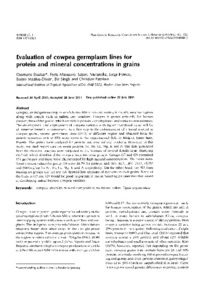| dc.contributor.author | Boukar, O. |
| dc.contributor.author | Massawe, F. |
| dc.contributor.author | Muranaka, S. |
| dc.contributor.author | Franco, J. |
| dc.contributor.author | Maziya-Dixon, B. |
| dc.contributor.author | Singh, B. |
| dc.contributor.author | Fatokun, C.A. |
| dc.date.accessioned | 2019-12-04T11:09:18Z |
| dc.date.available | 2019-12-04T11:09:18Z |
| dc.date.issued | 2011-12 |
| dc.identifier.citation | Boukar, O., Massawe, F., Muranaka, S., Franco, J., Maziya-Dixon, B., Singh, B. & Fatokun, C. (2011). Evaluation of cowpea germplasm lines for protein and mineral concentrations in grains. Plant Genetic Resources: Characterization and Utilization, 9(4), 515-522. |
| dc.identifier.issn | 1479-2621 |
| dc.identifier.uri | https://hdl.handle.net/20.500.12478/2016 |
| dc.description | Published online: 22 July 2011 |
| dc.description.abstract | Cowpea, an indigenous crop to sub-Saharan Africa, is found mainly in the dry savanna regions along with cereals such as millets and sorghum. Cowpea is grown primarily for human consumption of the grains, which are rich in protein, carbohydrates and contain some minerals. The development and deployment of cowpea varieties with higher nutritional value will be of immense benefit to consumers. As a first step in the enhancement of mineral content in cowpea grains, several germplasm lines (1541) of different origins and obtained from the genetic resources unit at IITA were sown in the experimental field in Minjibir, Kano State, Nigeria. The grains were analysed for protein and nine mineral contents. However, in this study, we shall report data on crude protein, Fe, Zn, Ca, Mg, K and P. The data generated from the chemical analysis were subjected to the ‘mixture of normal distributions’ clustering method, which distributed the cowpea lines into nine groups. Groups G7 and G9 contained 174 genotypes and these were characterized by high mineral concentrations. The mean nutritional content values for group G9 were 24.7% for protein, and 58.9, 41.5, 1107, 2132, 15,282 and 5664 mg/kg for Fe, Zn, Ca, Mg, K and P, respectively. On the other hand, the 363 lines making up groups G2, G3 and G6 showed low amounts of nutrients in their grains. Some of the lines in G7 and G9 would be good as parents to use in breeding programmes that aimed at developing nutrient-dense cowpea varieties. |
| dc.description.sponsorship | HarvestPlus |
| dc.format.extent | 515-522 |
| dc.language.iso | en |
| dc.subject | Cowpeas |
| dc.subject | Nutritional Value |
| dc.subject | Vigna Unguiculata |
| dc.subject | Diversity |
| dc.subject | Mineral Composition |
| dc.subject | Grain Legumes |
| dc.subject | Germplasm |
| dc.title | Evaluation of cowpea germplasm lines for protein and mineral concentrations in grains |
| dc.type | Journal Article |
| dc.description.version | Peer Review |
| cg.contributor.affiliation | International Institute of Tropical Agriculture |
| cg.coverage.region | Africa |
| cg.coverage.region | West Africa |
| cg.coverage.country | Nigeria |
| cg.isijournal | ISI Journal |
| cg.authorship.types | CGIAR single centre |
| cg.iitasubject | Cowpea |
| cg.journal | Plant Genetic Resources: Characterization and Utilization |
| cg.howpublished | Formally Published |
| cg.accessibilitystatus | Limited Access |
| local.dspaceid | 85758 |
| cg.targetaudience | Scientists |
| cg.identifier.doi | http://dx.doi.org/10.1017/s1479262111000815 |

